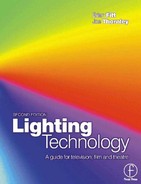1
Introduction
Every year we all hope there will be a wonderful new light source but tungsten and discharge still dominate the lighting industry. To aid the production of a higher light output from luminaires, lamp manufacturers have made some progress by producing tungsten lamps with more compact filaments and discharge lamps with shorter arcs. This allows the concentration of the light output by utilising the optics more efficiently. There are hints of important progress in the production of light from Light Emitting Diodes with suggested outputs of around 100 lumens/W. One tremendous advantage of LEDs is that the majority of their output is in the visible spectrum, thus avoiding the generation of ultraviolet (UV) and infrared. At this stage, it is difficult to envisage devices such as these being used in conventional luminaires.
Since the previous edition, the most significant advances have been in the motorised light sector. To overcome the restricted range of projected patterns and colours, the manufacturers of moving lights are looking to computer generated images coupled with digital projection. This enables real time programming of the luminaire output with an almost unlimited pattern and colour range. The main problem is obtaining a high enough light output to blend with existing lighting arrangements. At present, most digital projection is aimed at audio-visual presentations and cinema projection, where the screen brightness is of a fairly low order.
Fluorescent lighting, which was introduced on a fairly large scale as an aid to producing more efficient lighting, has now settled down as a soft source. It is now generally used with small tungsten and discharge sources in hybrid studios, such as news and talking head areas, to create comfortable working conditions.
New dimmers have been introduced which have moved away from thyristor technology to provide a sine wave output (almost)! This enables a controlled switching of the output waveform, thus avoiding the use of chokes to smooth the output, which has the advantage of reducing some of the problems with mains borne interference and lamp sing but most significantly, lowers the weight of the dimmer. Manufacturers are now integrating dimmers into the suspension system, with control by DMX loops.
Control systems have become increasingly sophisticated due to the need to control large numbers of moving lights. DMX512 appears to have been adopted as the standard form of control signal.
As a result of more stringent budgets, particularly in television (TV), equipment is not being replaced as frequently as it used to be. Most of the impetus for change is either caused by a safety problem or the need to introduce the latest ‘gizmo’.
We hope you will find the new streamlined edition as informative as the old one.
